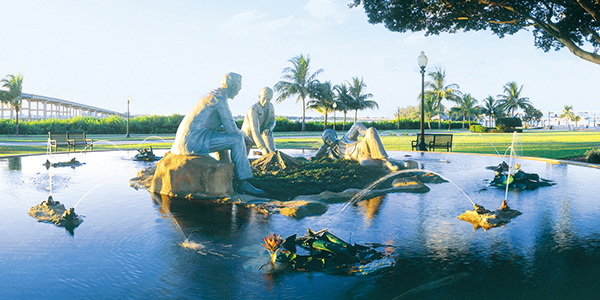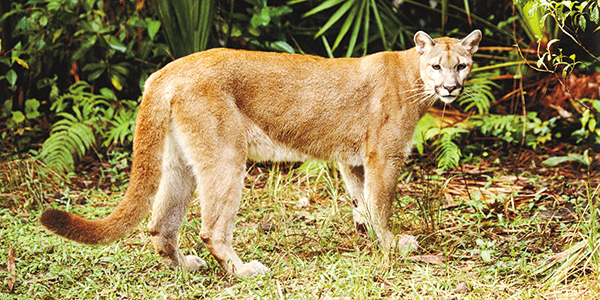Spotlight: Fort Myers
Edison fans and baseball buffs flock to this snowbird roost
Like the colors of a Gulf Coast sunset, Fort Myers presents a different image to all who visit. The shading begins with the location of the city itself, not on the seacoast but several miles inland along the Caloosahatchee River. While the Fort Myers area enters a vacation planner for beaches, it is really Fort Myers Beach and Sanibel Island that are in play—Fort Myers itself is a river town.
Located two hours from Tampa to the north and Miami to the southeast, Fort Myers is a happy medium between a relaxed coastal town and the bustling city. Tourists will discover a relaxed community that boasts a massive selection of seafood restaurants, top-flight museums and all the amenities of a large metropolitan area. It’s also got the laid-back vibe that travelers relish when visiting the Sunshine State. Tourists can stay local and enjoy attractions in town, or venture out to see some of the compelling cities and parks in outlying areas.

Getty Images/iStockphoto
City With a Bright Future
Founded in the 1800s, the city enjoyed rapid growth as visitors discovered its friendly climate and natural beauty.
In August 1885, Fort Myers was incorporated—with less than 350 residents. By 1898, the city had become a nationally known winter resort destination with the building of the Royal Palm Hotel. With the opening of the Atlantic Coast Line Railroad, connecting Punta Gorda to Fort Myers in May 1904, access to the Fort Myers area was greatly improved. The city continued to grow with the construction of the Tamiami Trail Bridge in 1924.
Fort Myers owes much of its fame to inventor Thomas Alva Edison, who thought the native bamboo that grew in abundance along the Caloosahatchee River might be the perfect filament for his incandescent light bulbs. It wasn’t, but Edison stayed 45 years anyway and convinced his friend Henry Ford to build a winter retreat in town as well. Today, the Edison and Ford Winter Estates, burnished by 20 acres of botanical gardens, are the most popular attractions in Fort Myers.
That residences should be the area’s top draw fits right in with the family-friendly Fort Myers ethos. The Imaginarium Science Center is an innovative blend of hands-on museum discoveries and live creatures cavorting in aquariums and an outdoor lagoon. Even Edison would envy the Discovery Lab exploration station.
Manatee Park on Palm Beach Boulevard is the place to spot the much-loved sea cows. Visitors can watch the creatures swim from three observation decks. The gentle creatures congregate in the river when the Gulf waters slip below 68 degrees in November and don’t rise again until March.
Meet the Major Leaguers
About the middle of February, the voices around Fort Myers take on the distinct accents of New England and the Upper Midwest. It is baseball spring training season, and the Minnesota Twins and Boston Red Sox have both trained in Fort Myers since the early 1990s. Currently, the teams get in shape only six miles apart, with the Twins hunkered down in Hammond Stadium and the Red Sox occupying their elaborate Fenway South complex with its replica of Boston’s famed Green Monster left-field wall. Fans can catch a Grapefruit League game in Fort Myers just about any day during the month of March.
If the sun gets too hot, the family can cool off with public ice skating sessions at the nearby Fort Myers Skatium.

© Lee County Visitor & Convention Bureau
Hitting the Waves
For real cooling down, nothing beats a trip on the water. Consider chartering a sailboat or powerboat from the Fort Myers Yacht Basin or riding the waves in a jet boat. Or take your time on a fishing boat, dropping a line into some of America’s most productive sport fishing waters. When it comes to real leisure on the water, Fort Myers and surrounding Lee County are home to more than 20 establishments that rent paddleboards, kayaks and other small craft. Adventurous paddlers can set out on the 190-mile Great Calusa Blueway Paddling Trail. With more than 80 access points, the Blueway is conveniently marked with signs and will accommodate any level of paddler. Expect to see Atlantic bottlenose dolphins, manatees, sea turtles and any of 300 common species of birds on your journey as you dip in and out of barrier islands and mangrove-dotted estuaries.
While other southwest Florida towns play up their Gulf of Mexico beaches, Fort Myers offers the languid pace of a historic river town. In its refurbished River District, art galleries, eclectic boutiques and vibrant eateries mingle along brick-lined streets while the Caloosahatchee River ambles past. Monthly art and music walks make the waterfront entertainment district a year-round must-see.
On permanent display in the Historic River District are rows of historic buildings that have been restored and preserved. Perhaps the most interesting structure in Fort Myers is the town’s former post office, which now houses the Sidney & Berne Davis Art Center. When it was constructed during the height of the Great Depression in 1933, the federal building was lauded as one of the most attractive post offices in any town the size of Fort Myers in America. Remarkably, it featured 24-hour-a-day open-air lockboxes. Embedded in the building’s limestone walls are coral and seashells. As you browse through the world-class art, you’ll get a sense of the fascinating, quirky history of Fort Myers.
Although a river town, Fort Myers is just a hop away from the famous white powder sand beaches of the Florida Gulf Coast. Short bridges link the mangrove-speckled mainland with San Carlos Island, popular for its restaurants, and busy Fort Myers Beach. Bring lots of sunscreen and a good book for a day at the beach, or walk the shore in search of great scenery.
Do the Sanibel Stoop
A three-mile causeway leads to Sanibel Island, where visitors engage in the time-honored practice known as the “Sanibel Stoop,” the best way to gather up the treasures from the sea in one of the best shelling spots in the world. The popular barrier island sports 22 miles of bike paths in addition to its 15 miles of unspoiled beach, and Sanibel’s undeveloped mangrove ecosystem is the most expansive in the country. Dog owners will want to point south of Fort Myers to Bonita Springs and one of the few beaches along Florida’s 1,380 miles of coastline, where dogs can romp.
Nature lovers flock to the Calusa Nature Center, which spotlights Southwest Florida’s natural history along three nature trails and a bird aviary. The center’s planetarium brings the solar system to life for visitors.
If that is too much nature, the Fort Myers River District Farmer’s Market operates every Thursday under the Caloosahatchee Bridge and brings the natural bounty of Southwest Florida into town.

© Lee County Visitor & Convention Bureau
Bonita Springs
Beyond Fort Myers, several fantastic cities merit exploration. Put Bonita Springs on your list of side trips.
Bonita Springs is situated on the southwest coast of Florida in Lee County near Cape Coral and Fort Myers. Benefiting from a tropical climate, Bonita Springs is located on both the Gulf of Mexico and Estero Bay. The Imperial River flows through the city’s downtown district, emptying into Estero Bay.
With “small-town charm and a bright future”—the city’s motto—Bonita Springs boasts several alluring beaches as well as cultural art attractions. The Center for the Arts of Bonita Springs hosts local, regional, and national traveling exhibitions as well as offering art classes and multiple community events. The arts organization, which is spread across two campuses, holds the annual Bonita Springs National Arts Festivals in January, February and March in the historic downtown districts. Other local events held by various organizations, such as the Old Fashion Fish Fry and CREW Benefit Concert, keep locals and visitors entertained.
Bonita Beach Park features a swimming area and boardwalk along with picnic shelters and a gazebo. In 2013, Forbes ranked Barefoot Beach Preserve Park—one of the last undeveloped barrier islands on Florida’s southwest coast—the sixth best beach in the nation. Wildlife lovers and sightseers alike will enjoy Lover’s Key State Park, a wildlife haven composed of four barrier islands that feature hiking and biking trails and miles of pristine beaches. Just east of Bonita Springs, visitors will discover the Corkscrew Swamp Sanctuary, a Bald Cypress reserved managed by the National Audubon Society.
Punta Gorda Day Trip
One of the most interesting cities near Fort Myers is Punta Gorda, a town slammed by Hurricane Charley in 2004 and rebuilt into a fun-filled recreation mecca.
The rebirth of Punta Gorda is symbolized by the Harborwalk that hugs the water’s edge of the Peace River for more than two miles. In Laishley Park, the concrete walk passes the “Spirit of Punta Gorda” sundial that symbolizes the community’s response to Hurricane Charley. Harborwalk links to Fisherman’s Village, an upscale waterfront shopping and entertainment complex constructed on a 1928 municipal pier. The Punta Gorda Linear Park traces the former rail bed of the Florida Southern Railroad in the downtown.
The Punta Gorda Historical Mural Society rides herd over two dozen public paintings depicting the city’s heritage that dates back to the 19th century, when Punta Gorda was the southernmost stop on the railroad. The Society also provides walking tour maps to explore the government seat of Charlotte County. Artifacts and exhibits are presented in the Punta Gorda Atlantic Coast Line Depot, constructed in a Mediterranean Revival style in 1928. The Blanchard House Museum of African American History collection can be found in the former home of sea captain Joseph Blanchard.
Recreation in Punta Gorda points towards the “thin waters” of Charlotte Harbor, which are ideal for small and medium-sized craft and sailboats. Deep sea fishermen need only navigate out past the sheltered harbor waters to reach the prime sport fishing grounds where big silver king tarpon feed. Some 84 percent of the shoreline is preserved land, and the Charlotte Harbor Preserve State Park is Florida’s fourth largest state park.
On the shore, Punta Gorda is a whirlwind of activity, beginning with farmer’s markets every Saturday and Sunday and Downtown Merchants Gallery Walks the third Thursday of every month. Seafood festivals take place in the spring and fall, and the Peace River National Art Show in March attracts artists from across the country. After a busy day at Punta Gorda, return to Fort Myers and rest up for another day of fun.
For More Information
The Beaches of Fort Myers and Sanibel
800-237-6444
www.fortmyers-sanibel.com
Florida Department of Tourism
888-735-2872
www.visitflorida.com







